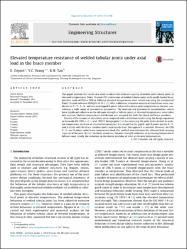Elevated temperature resistance of welded tubular joints under axial load in the brace member
Erişim
info:eu-repo/semantics/restrictedAccessTarih
2014Erişim
info:eu-repo/semantics/restrictedAccessÜst veri
Tüm öğe kaydını gösterÖzet
This paper presents the results of a study to obtain the ultimate capacity of welded steel tubular joints at elevated temperatures. Finite Element (FE) simulations of welded tubular joints with axially loaded brace member made of CHS or SHS at different elevated temperatures were carried out using the commercial Finite Element software ABAQUS v6.10-1 [1]. After validation, extensive numerical simulations were conducted on T-, Y-, X-, N- and non-overlapped K-joints subjected to brace axial compression or tension, considering a wide range of geometrical parameters. The material and geometrical nonlinearities, which have significant influence on the ultimate strength of tubular joints at elevated temperatures, were taken into account. Uniform temperature distribution was assumed for both the chord and brace members. Results of the numerical simulation were compared with calculation results using the design equations in Eurocode EN 1993-1-2 [3] and CIDECT design guide [16] but replacing the yield stress of steel at ambient temperature by those at elevated temperatures. It is found that for gap K- and N-joints and for T-, Yand X-joints with the brace member under axial tensile load, this approach is suitable. However, for CHS T-, Y- and X-joints under brace compression load, this method overestimates the ultimate load carrying capacity of the joint. In fact, for these situations, the joint strength reduction at increasing temperatures follows more closely the reduction in the elastic modulus of steel at elevated temperatures.


















